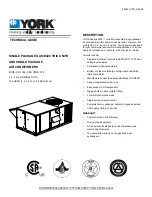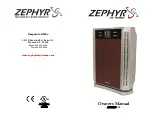
TTJ-0198 (10/97)
(Page 24 of 64)
The wet rag around the reversing valve will elimi-
nate conduction of heat to the valve body when
brazing the line connection.
IMPORTANT
ANY SEALED SYSTEM REPAIRS TO HEAT PUMP
MODELS REQUIRES THE INSTALLATION OF A
SUCTION LINE DRIER IN THE SUCTION LINE BE-
TWEEN THE COMPRESSOR AND THE REVERS-
ING VALVE. ELECTRIC HEAT MODELS REQUIRE
A LIQUID LINE DRIER (SEE PARTS LIST FOR
PART NUMBERS.)
SEALED REFRIGERATION SYSTEM REPAIRS
EQUIPMENT REQUIRED
1. Voltmeter
2. Ammeter
3. Ohmmeter
4. E.P.A. Approved Refrigerant Recovery System.
5. Vacuum Pump (capable of 200 microns or less
vacuum.)
6. Acetylene Welder
7. Electronic Halogen Leak Detector (G.E. Type H-6
or equivalent.)
8. Accurate refrigerant charge measuring device such
as:
a. Balance Scales - 1/2 oz. accuracy
b. Charging Board - 1/2 oz. accuracy
9. High Pressure Gauge - (0 - 400 lbs.)
10. Low Pressure Gauge - (30 - 150 lbs.)
11. Vacuum Gauge - (0 - 1000 microns)
EQUIPMENT MUST BE CAPABLE OF:
1. Recovery CFC's as low as 5%.
2. Evacuation from both the high side and low side of
the system simultaneously.
3. Introducing refrigerant charge into high side of the
system.
4. Accurately weighing the refrigerant charge actu-
ally introduced into the system.
5. Facilities for flowing nitrogen through refrigeration
tubing during all brazing processes.
HERMETIC COMPONENT REPLACEMENT
The following procedure applies when replacing com-
ponents in the sealed refrigeration circuit or repairing
refrigerant leaks. (Compressor, condenser, evaporator,
capillary tube, refrigerant leaks, etc.)
1.
Recover the refrigerant from the system at the
process tube located on the high side of the sys-
tem by installing a line tap on the process tube.
Apply gauge from process tube to EPA approved
gauges from process tube to EPA approved re-
covery system. Recover CFCs in system to at
least 5%.
2.
Cut the process tube below pinch off on the suc-
tion side of the compressor.
3.
Connect the line from the nitrogen tank to the
suction process tube.
4.
Drift dry nitrogen through the system and unsol-
der the more distant connection first. (Filter drier,
high side process tube, etc.)
5.
Replace inoperative component, and always in-
stall a new filter drier. Drift dry nitrogen through
the system when making these connections.
6.
Pressurize system to 30 PSIG with proper refrig-
erant and boost refrigerant pressure to 150 PSIG
with dry nitrogen.
7.
Leak test complete system with electric halogen
leak detector, correcting any leaks found.
8.
Reduce the system to zero gauge pressure.
9.
Connect vacuum pump to high side and low side
of system with deep vacuum hoses, or copper
tubing. (Do not use regular hoses.)
10.
Evacuate system to maximum absolute holding
pressure of 200 microns or less. NOTE: This pro-
cess can be speeded up by use of heat lamps, or
by breaking the vacuum with refrigerant or dry
nitrogen at 5,000 microns. Pressure system to 5
PSIG and leave in system a minimum of 10 min-
utes. Recover refrigerant, and proceed with evacu-
ation of a pressure of 200 microns or a minimum
of 10%.
Содержание YL24J35A
Страница 7: ...TTJ 0198 10 97 Page 7 of 64 COOLING LOAD ESTIMATE FORM...
Страница 9: ...TTJ 0198 10 97 Page 9 of 64...
Страница 14: ...TTJ 0198 10 97 Page 14 of 64...
Страница 26: ...TTJ 0198 10 97 Page 26 of 64...
Страница 27: ...TTJ 0198 10 97 Page 27 of 64...
Страница 28: ...TTJ 0198 10 97 Page 28 of 64...
Страница 29: ...TTJ 0198 10 97 Page 29 of 64...
Страница 30: ...TTJ 0198 10 97 Page 30 of 64...
Страница 36: ...TTJ 0198 10 97 Page 36 of 64...
Страница 37: ...TTJ 0198 10 97 Page 37 of 64 WIRING DIAGRAM FOR MODELSYS13J33 YM18J34A YL24J35A...
Страница 39: ...TTJ 0198 10 97 Page 39 of 64...
Страница 40: ...TTJ 0198 10 97 Page 40 of 64...
Страница 46: ...TTJ 0198 10 97 Page 46 of 64...
Страница 47: ...TTJ 0198 10 97 Page 47 of 64...
Страница 52: ...TTJ 0198 10 97 Page 52 of 64...
Страница 53: ...TTJ 0198 10 97 Page 53 of 64...
Страница 57: ...TTJ 0198 10 97 Page 57 of 64...
Страница 58: ...TTJ 0198 10 97 Page 58 of 64...
















































